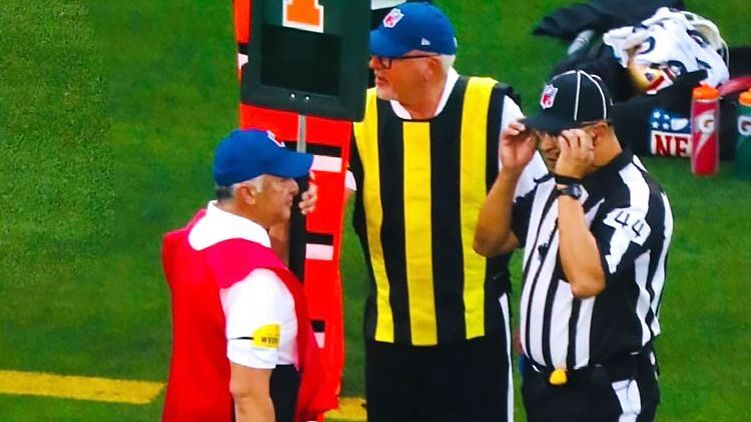VIRGIL CARTER WAS greater than an informal observer as he sat in his Apple Valley, California, lounge Jan. 28 to observe the NFC Championship Recreation. Actually, it is perhaps mentioned the 78-year-old former quarterback performed a key position, particularly when it got here to 2 controversial performs.
When Detroit Lions coach Dan Campbell ignored conference on a pair of fourth-down calls within the second half, failing to transform deep in San Francisco 49ers’ territory, critics blamed Campbell’s adherence to analytics as one of many causes for the Lions’ 34-31 loss.
Carter’s response: “Do not blame me.”
It might sound unusual that somebody who performed within the NFL for seven seasons — with modest success — would want to deflect blame 48 years after retiring, however Carter is greater than a former quarterback.
Better of NFL Nation

• What new know-how means to the NFL• Mayfield pleased to have extra command in 12 months 2• Jets’ protection trying to repeat success• Can Jayden Reed emerge as Packers’ WR1?• Lamar Jackson on level in return to Ravens’ OTAs
He’s thought-about one of many founders of contemporary NFL analytics. And whereas analytics assist coaches take advantage of knowledgeable choices, they do not assure success. ESPN Analytics barely favored Campbell’s choices, however the executions fell quick, so do not blame Carter.
In 1971, Carter and Northwestern professor Robert Machol printed a three-page paper referred to as “Operations Analysis on Soccer.” The examine included two essential ideas — completely different yard traces and conditions on the sector carried completely different anticipated level values, and groups needs to be extra aggressive in sure fourth-down conditions.
It took a couple of many years, however Carter and Machol’s findings have made a huge impact. The purpose-value mannequin, which is now generally known as anticipated factors added (EPA), is utilized by coaches in any respect ranges to guage offensive effectiveness. All NFL groups have no less than one analytics staffer, and school packages are utilizing third-party consulting companies to guage facets comparable to which cornerback is almost certainly to get beat on a given passing play.
And sure, extra groups are maintaining the offense on the sector on fourth downs.
“Numerous what’s in that paper is actually the identical factor that is being achieved now,” mentioned Michael Lopez, the NFL’s senior director of soccer information and analytics. “The numbers have modified as a result of soccer’s developed, however simply the concept that existed to this point earlier than folks obtained onto it, I feel it is fairly neat.”
CARTER WAS SELECTED within the sixth spherical of the 1967 draft by the Chicago Bears, however he was not a typical rookie.
Whereas most gamers stay near the workforce’s apply facility in Lake Forest, Carter lived in downtown Chicago. After majoring in statistics on an instructional scholarship at BYU, Carter wished to pursue an MBA at Northwestern, which provided these programs at its downtown campus, alongside Lake Michigan.
Bears proprietor George Halas, who was in his final yr as head coach, not solely inspired it however, Carter mentioned, gave him a stipend for room and board so the quarterback might keep within the metropolis but even be accessible to observe tape and study the playbook.
Machol turned out to be the right professor for Carter’s examine of qualitative evaluation. Machol was a Harvard grad who served as a Navy lieutenant commander in World Battle II. He took his Northwestern college students to Cubs video games on subject journeys to review how choices affected outcomes and win chances.
And as a lot as Machol loved making use of his work to sports activities, Carter loved working with numbers.
“I’ve simply at all times been infatuated with having the ability to work to a conclusion of worth, and it was both proper or fallacious,” Carter informed ESPN.
Editor’s Picks
2 Associated
They got here up with the concept to measure the worth of ball placement on a soccer subject. Of their work, Carter and Machol famous that no main research had been achieved other than a letter to the editor to a analysis quarterly, written by Charles Mottley in 1954.
To do that, Carter wanted play-by-play data. With Halas’ blessing, Carter reached out to the PR workplace for every NFL workforce and acquired information from each workforce besides the Oakland Raiders. Carter crammed within the hole with data from their opponent and charted 56 video games through the first half of the 1969 season.
The most important discovering was about “having an approximate information of the worth of getting the ball at a selected level on a subject,” they wrote of their paper. That impacted every part from play choice close to the aim line to the idea of the “coffin nook” punt that locations the ball as deep as doable into opponent territory with out kicking the ball into the tip zone.
An instance could be drawn from the NFC Championship Recreation. San Francisco had 0.9 anticipated factors when it had a first-and-10 by itself 25-yard line. Later in that drive, the anticipated factors jumped as much as 3.0 for a first-and-10 at Detroit’s 34-yard line, in response to ESPN’s EPA mannequin.
The concepts and notions have been thought-about radical on the time. And for many years, they went unnoticed.
Stated Brian Burke, a senior analytics specialist at ESPN: “It was actually method, method forward of its time.”
BY THE TIME the report was printed, Carter was now not in Chicago. He was waived after the 1969 season and ended up with the Buffalo Payments for a short interval. The Payments traded him to the Cincinnati Bengals in trade for a sixth-round decide earlier than the 1970 season started. That is when Carter’s work gained extra traction. Not solely was Paul Brown, the Bengals’ head coach and workforce founder, , however the quarterbacks coach additionally took discover. His title was Invoice Walsh.
Lengthy earlier than Walsh received Tremendous Bowls with the San Francisco 49ers, he was growing the origins of his fabled West Coast offense with Carter in Cincinnati. For instance, they labored by means of the danger evaluation of throwing an out route close to the aim line and determined it was safer to throw the ball close to the pylon as a substitute of attempting to hit a receiver in stride. Carter additionally defined to Walsh why the possibilities of scoring a landing are higher if a receiver positive factors a primary down on the 15-yard line as a substitute of the ten.
“He thought, ‘Properly, that is fascinating,'” Carter mentioned. “However then he is [also] pondering, ‘Properly, how can I clarify that to Paul Brown? As a result of if we do not rating, I will be the man within the sizzling seat.'”
In addition they labored on an idea that’s commonplace for contemporary quarterbacks — studying a protection and getting the ball out rapidly. When Walsh took over as 49ers coach in 1979, Carter, then retired, took his son to coaching camp and was instantly greeted by quarterback Joe Montana.
The very first thing Montana informed him was that he used to get “rattling bored with taking a look at you make a five-step drop and throw to Bob Trumpy in a curl over the center” in sport movie as Walsh put in the West Coast in San Francisco.
After going largely undeveloped, EPA, together with different present ideas, such because the constructing blocks for gadgets comparable to rush yards over expectation and Whole QBR, have been both reintroduced or expanded within the 1988 guide, “The Hidden Recreation of Soccer,” by Bob Carroll, Pete Palmer and John Thorn.
These works referenced a elementary precept — not all yards are gained equally.
For instance, in Week 16 of final season, Inexperienced Bay Packers quarterback Jordan Love had an 8-yard completion to realize a primary down on third-and-7 and netted the Packers an EPA of two.1. Nevertheless, within the 21 situations {that a} workforce gained 8 yards on third-and-9 and was in need of a primary down, 19 of these performs resulted in a damaging EPA. However every play was nonetheless thought-about an 8-yard achieve within the last field rating.
It wasn’t till 2008, when Burke formally launched EPA, that these ideas started to realize momentum. A fighter pilot by commerce who labored as a protection contractor with American allies, Burke crunched the numbers on lengthy worldwide flights. He borrowed a log-in for the NFL’s play-by-play information and finally constructed an anticipated factors mannequin for all 4 downs.
Ultimately, the analytics shifted from data on web sites on the fringes of the game to being embraced and utilized by each NFL franchise.
“Now it is all over the place,” Burke mentioned. “It is form of like watching your children form of develop up and have their very own lives, transfer out, get married and have their very own children.”
IF IT WAS ever thought-about a revolution, the numbers present the warfare is over.
There is a 33% improve in groups going for it on fourth-and-1, in response to Lopez. He additionally added that almost all of groups have an analytics staffer speaking real-time chances throughout video games by way of the teaching headsets.
The rise in analytics utilization, Burke mentioned, could possibly be chalked as much as shops comparable to his authentic web site — AdvancedFootballAnalytics.com — that confirmed the inefficiencies in earlier metrics. Followers and groups additionally have been uncovered to articles and leaderboards that confirmed which gamers have been extra environment friendly. It additionally grew to become a lot simpler for these fascinated about analytics to entry information and statistical fashions.
Among the most profitable groups over current years, such because the 49ers, Baltimore Ravens, Philadelphia Eagles and Payments, have been among the many groups that the majority use analytics.
Sam Francis is the Bengals’ soccer information analyst and leads the workforce’s analytics. His workplace is on the identical flooring as these of the coaches on the workforce facility, and since he began working within the NFL in 2017, he has seen how the superior numbers have grow to be extra prevalent.
TeamEPA49ers.14Cowboys.11Bills.09Dolphins.08Ravens.07Rams.07Lions.07
“The extra conversations we’ve, the extra initiatives we do, the extra research we do, they will perceive what I’ve entry to and the way it may be used,” Francis mentioned.
When he began out, stats comparable to EPA have been buried on the best facet of spreadsheet stories. Now, EPA has moved farther left as extra folks worth it. When the Bengals evaluated speeding offense this offseason, EPA was the primary column as they ranked groups throughout the league by run idea. Veteran offensive line coach Frank Pollack, a no-nonsense ex-NFL lineman, was the one explaining the numbers to the remainder of the employees.
The method in Cincinnati and elsewhere across the league exhibits the significance of integrating the analytics division with coaches, particularly now that correct velocity and monitoring information is available.
“[The] greatest organizations at this level, your analysts are totally built-in together with your coaches or your scouts,” Lopez mentioned. “You are going to overhear stuff that you simply would not have considered. Then you definitely overhear it and you are like, ‘Holy cow, we will measure that. We will examine that.'”
The identical could be mentioned on the school stage. Championship Analytics patented a sport guide in 2016 that coaches maintain on the sideline to gauge whether or not to go for it on fourth down.
“Some folks previously have been cussed — ‘Hey, we will run this play as a result of I have been operating it for the final 20 years, or no matter it’s,'” mentioned Baylor offensive coordinator Jake Spavital, whose grandfather coached Virgil Carter for a season within the World Soccer League. “And then you definitely’re taking a look at it and also you’re simply not getting the outcomes as these different performs are, so why ought to we be operating these performs that always?”
THE MORE TECHNOLOGY advances, the extra soccer and the numbers that form the sport will evolve.
One of many huge questions, Burke mentioned, is how synthetic intelligence can be used to assist interpret the entire superior participant monitoring information that comes from microchips within the soccer and in gamers’ shoulder pads. However, as with all information, understanding it requires understanding how the sport is performed, too.
“I needed to study the sport at a deeper stage,” Burke mentioned. “And now coaches type of should study just a little bit about analytics, and we’re assembly in a contented center.”
Carter and Machol unknowingly modeled that dynamic greater than 50 years in the past. The synergy and belief that produced their groundbreaking paper is simply as important now because it was then.
What to know for the 2024 NFL offseason

• 2024 NFL schedule: Predictions, takeaways• OTA, minicamp dates for all 32 groups• Put up-draft 2024 Energy Rankings: 1-32 ballot• Greatest remaining gap on each roster (ESPN+)• One QB query for all 32 groups (ESPN+)• Draft: See all 257 picks | Decide evaluation
“It is not their job to belief me,” Francis mentioned. “I’ve obtained to earn that. I’ve obtained to realize that. As a result of on the finish of the day, there’s solely so many choices {that a} coach makes, and they will affect how he is seen along with his job and his profession.”
A part of the evolution of analytics is how a lot simpler it has grow to be to assemble and ship the info.
When Carter set out on his mission in 1970, the whole course of took greater than 160 hours. Burke refined and modernized EPA through the summer time of 2008. Now, Francis can tweak stories the day after a sport in as little as quarter-hour.
However though the processing time has shortened, the target has remained the identical since these days again at Northwestern.
“EPA, from a common understanding throughout the league now, has most likely solely been — to be beneficiant — the final 10 years,” Francis mentioned. “[Carter] was attempting to uncover these things 50 years in the past.”

























